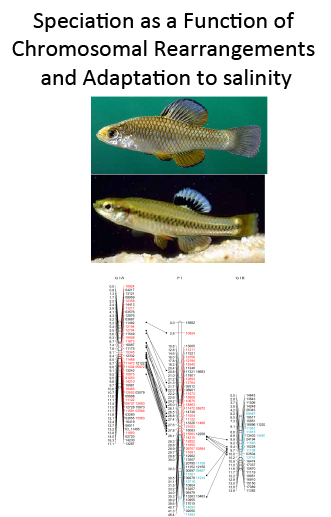Ongoing Research Themes in the Lab

1. Sensory drive in bluefin killifish. Bluefin killifish provide an excellent system for asking questions concerning selection in diverse lighting environments, phenotypic plasticity in color patterns and color vision, and the determinants of male conspicuousness. Male bluefin killifish are polymorphic in coloration, and the relative abundance of color morphs varies among lighting habitats. The anal fin is particularly variable in coloration. In swamp populations, males with blue anal fins are numerically abundant. In springs, yellow males are common. Males with red anal fins are present in all populations. Current work by Lisa Mitchem is investigating the extent to which lighting environment affects male reproductive success and male susceptibility to predators and what determines these patterns.
The bluefin killifish system also lends itself well to asking questions about the evolution of phenotypic plasticity. Our past work has shown the expression of blue is determined by both genetic and environmental inputs. In particular, there is pronounced genetic variation in phenotypic plasticity where some (but not all) males express blue anal fins when they are exposed to tannin-stained water early in life. We are currently examining the extent to which this varies across populations.
The bluefin killifish system also lends itself well to asking questions about the evolution of phenotypic plasticity. Our past work has shown the expression of blue is determined by both genetic and environmental inputs. In particular, there is pronounced genetic variation in phenotypic plasticity where some (but not all) males express blue anal fins when they are exposed to tannin-stained water early in life. We are currently examining the extent to which this varies across populations.

2. Speciation in Killifish. The lab is also interested in the evolution of reproductive isolating barriers between killifish. Particularly, we are studying the roles of natural selection and chromosomal rearrangements in promoting speciation in this group. Bluefin killifish are found primarily in freshwater whereas the sister species is euryhaline and is found in fresh, brackish, and marine waters. The two species also differ in a chromosomal rearrangement. Hence, the system provides an excellent framework for asking whether natural selection and/or chromosomal speciation is taking place. In our past work, we have also documented high levels of reinforcement between the two species where there is selection to avoid heterospecific matings in areas of sympatry. A former post-doc, Genny Kozak, has also shown the reinforcement between species may be leading to 'cascade reinforcement' among populations within species. In other words, selection favoring increased preferences to mate with members of the same species may also make individuals more likely to mate with individuals from their own populations (over foreign populations). Michelle St. John is currently following up these findings.
We are also developing genomic resources for this system. In past work, the lab generated genetic linkage maps for the two species and discovered a major chromosomal rearrangement. Emma Berdan phenotyped a number of hybrid offspring to determine the areas of the genome involved in reproductive isolation and adaptation to fresh versus salt water. We are currently sequencing the genomes of both species.
We are also developing genomic resources for this system. In past work, the lab generated genetic linkage maps for the two species and discovered a major chromosomal rearrangement. Emma Berdan phenotyped a number of hybrid offspring to determine the areas of the genome involved in reproductive isolation and adaptation to fresh versus salt water. We are currently sequencing the genomes of both species.

3. Speciation in Darters. The lab is also interested in the roles of female choice, male choice, male competition, and reinforcement in speciation in darters. We are particularly interested in speciation in the rainbow darter and Ceasia (formerly, orangethroat darter) group. Muchu Zhou and Rachel Moran have been working on this project. Much to our surprise, the brilliant color pattern appears to serve mainly in male/male competition and in male recognition of conspecific versus heterospecific males. Males also appear to play the predominant role in behavioral isolation. We are investigating the potential for reinforcement to play a role in this system.
